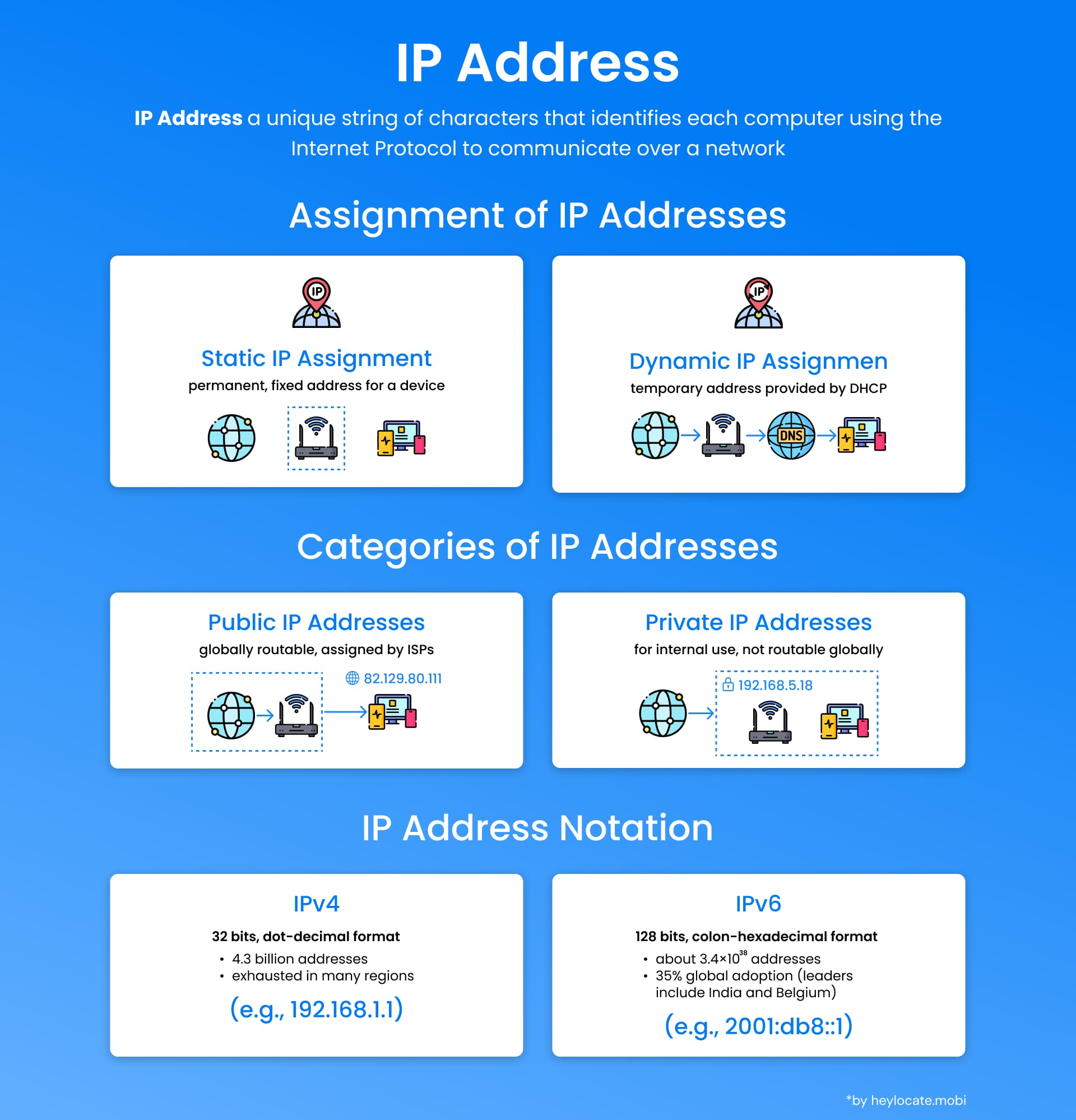IP Address
What is an IP Address?
An IP address, short for Internet Protocol address, is a distinct numerical identifier allocated to devices within a computer network utilizing the Internet Protocol (IP) for communication. It fulfills dual roles:
- Network Interface Identification: This entails uniquely identifying a device’s network interface, facilitating communication within a network.
- Location Addressing: Through IP addressing, data packets can be effectively addressed and routed across diverse networks.

IP Address Notation
IP addresses are expressed in human-readable notations:
- IPv4: Uses 32 bits, written in dot-decimal format (e.g., 192.168.1.1).
- IPv6: Uses 128 bits, written in colon-hexadecimal format (e.g., 2001:db8::300.600e).
Comparative table of IP address versions:
| Feature | IPv4 (32-bit) | IPv6 (128-bit) |
|---|---|---|
| Address Format | Dot-decimal (e.g., 192.168.1.1) | Colon-hexadecimal (e.g., 2001:db8::300.600e) |
| Address Space | Limited | Significantly larger |
| Scalability | Lower | Higher |
| Development Status | Mature | Newer |
| Private Networks | Supported (reserved address ranges) | Supported (ULAs and Link-local addresses) |
| Subnetting | Supported (CIDR and subnet masks) | Supported (CIDR) |
| Routing Efficiency | Lower | Higher |
Management of IP Address Space
The global management of IP address space falls under the jurisdiction of the Internet Assigned Numbers Authority (IANA). IANA delegates blocks of IP addresses to five Regional Internet Registries (RIRs), which subsequently distribute them to Local Internet Registries (LIRs) and Internet Service Providers (ISPs). These entities then assign the IP addresses to end users.
Assignment of IP Addresses
Network administrators assign IP addresses to devices on a network. This assignment can be:
- Static: A permanent IP address assigned to a specific device.
- Dynamic: An IP address automatically assigned to a device by a service like DHCP (Dynamic Host Configuration Protocol) for a configurable lease time.
Subnetworks and Addressing Techniques
| Subnetworks and Addressing Techniques | Description |
|---|---|
| Subnetworks in IP | IP networks can be divided into smaller networks called subnetworks or subnets. IP addresses consist of a network prefix and a host identifier. Both IPv4 and IPv6 utilize the concept of Classless Inter-Domain Routing (CIDR), although the term subnet mask is specific to IPv4 |
| Dynamic IP Addresses | Dynamic IP addresses are assigned by network services like DHCP (Dynamic Host Configuration Protocol). These addresses change over time, facilitating efficient use of limited address space |
| Static IP Addresses | Static IP addresses are permanent addresses assigned to devices. They are typically used for network infrastructure components such as routers, switches, and servers |
| Private and Link-local Addresses | Private addresses are reserved for use within private networks and are not routable on the global Internet. Link-local addresses are used for local communications, specifically for devices on the same physical network segment |
IP Address Conflicts and Resolutions
Conflicts occur when multiple devices claim the same IP address, leading to network issues. These conflicts can arise from various sources and require careful management to resolve.
IP Address Types
| Type | Description | Usage |
|---|---|---|
| Unicast Addressing | Assigns a unique IP address to a single device | Enables communication with a specific device on a network |
| Multicast Addressing | Enables sending data packets to a group of devices simultaneously | Used for efficient transmission to multiple receivers (e.g., video conferencing, online gaming) |
| Anycast Addressing | Directs data packets to the nearest device from a group of devices identified by a single IP address | Useful for load balancing and content delivery networks (CDNs) where the closest server responds |
Public vs. Private IP Addresses
- Public IP Addresses: Routable on the global internet, typically assigned by ISPs to user devices.
- Private IP Addresses: Reserved address ranges not routable on the public internet, used for internal networking within private organizations.
References
- DOD Standard Internet Protocol. DARPA, Information Sciences Institute. January 1980.
- J. Postel, ed. (September 1981). Internet Protocol, DARPA Internet Program Protocol Specification. IETF.
- “DHCP and Automatic Private IP Addressing”. Microsoft Learn.
- IP address – Wikipedia
- What is an IP Address – Definition and Explanation
- 6 Basic Things to Know About IP Addresses
- What Is An IP Address? How Does It Work?